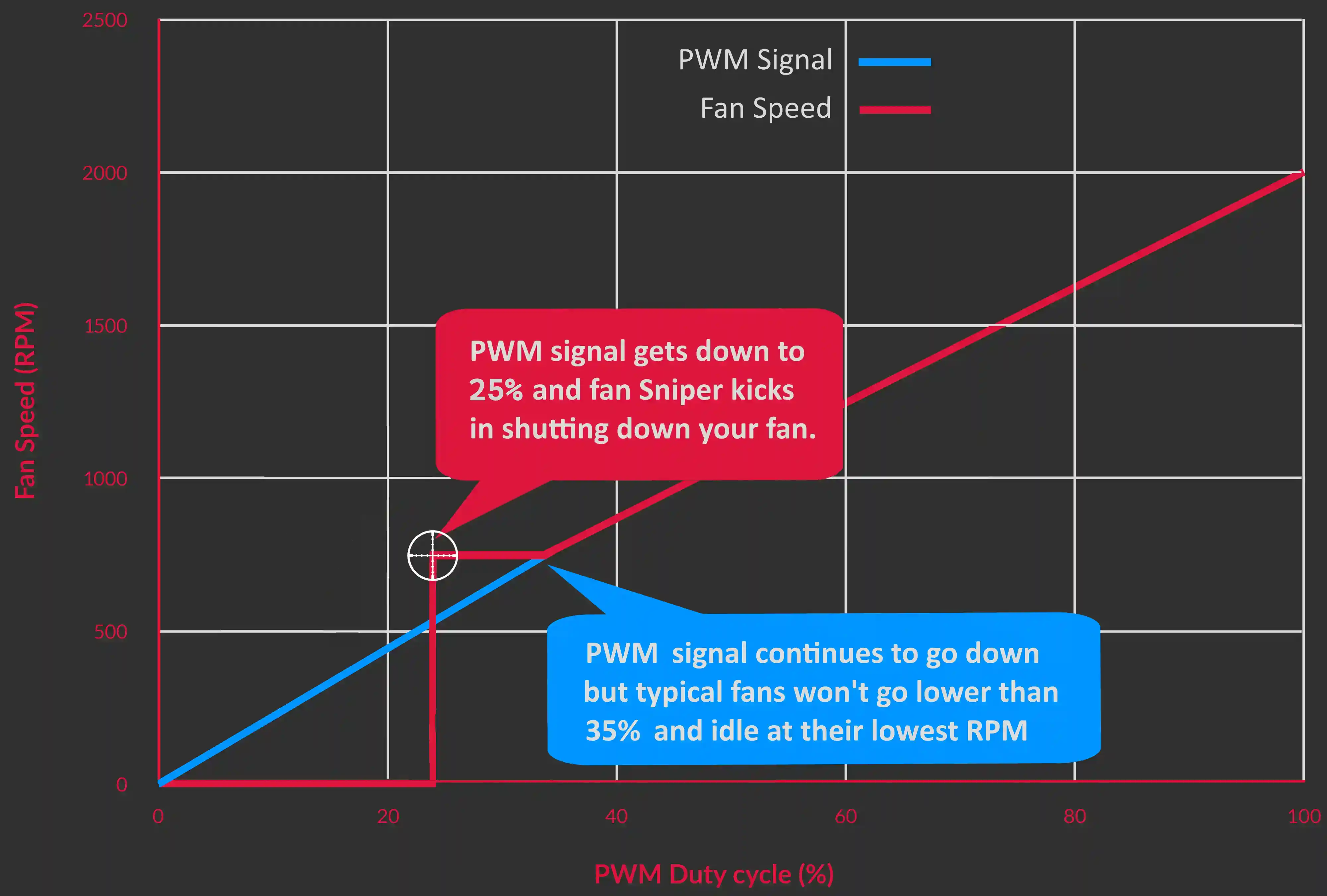

You've spent a lot of time and money building out your perfect battle station to handle the heat of combat, but what about when you're away from the battlefield? Most PWM fans will only ramp down to a low RPM but won't actually stop, and your awesome build most likely has more than enough water cooling to passively cool with no fans while you surf the web. So don't let your fans needlessly run, pulling in dust, making noise, and wasting power. let the fan sniper take them out!
fan Sniper fixes what most PC fans fail to do, STOP... Your GPU fans have 0db aka Fan-Stop mode, why run the fans when there isn't enough heat to bother? The fan Sniper gives this same functionality to any PC fan you like.

We build our rigs to take a beating from some of the toughest games and applications out there, but when we just surf the net or whip up a quick meme, even the lowest of idle fan speeds isn't really needed. Most water cooled PC's can run with only one or even no fans on during these casual tasks. Maybe you only want to snipe some of your fans, you can use the fan Sniper on a single fan, or using the PWM fan splitter you can power as many fans as your motherboard header will support, or use the SATA powered breakout cable to power up to 2 Amps worth of fans!
The fan Sniper was specially designed for custom built PC's by PC builders, these are just a few solutions the fan Sniper provides:
![]() Lower noise level.
Lower noise level.
![]() Less dust and dirt inside your sweet rig.
Less dust and dirt inside your sweet rig.
![]() No startup clunky noises like when you use the bios DC setting on a PWM 4-Pin fan.
No startup clunky noises like when you use the bios DC setting on a PWM 4-Pin fan.
![]() No twitching fans or burnt up fan motors like when you use the bios DC setting on a PWM 4-Pin fan.
No twitching fans or burnt up fan motors like when you use the bios DC setting on a PWM 4-Pin fan.
![]() Built-in short circuit protection for your motherboard or fan controller.
Built-in short circuit protection for your motherboard or fan controller.
Your motherboard or fan controller must support fan curves that go to at least 5% output at its lowest PWM setting. Most PC fans wont obey a PWM signal below 35% and most will just spin at their minimum rated RPM. Some people get around this by setting their motherboard bios or fan controller to DC mode on their PWM fans, then use fan curves to lower the DC voltage to the fan. Though this kind of works, it causes fan motor heating (voltage to the motor while stalled), twitching at low speeds, and noisy startup from a stop.
The fan Sniper does it right and monitors the PWM signal, once the PWM signal falls below 25% or so the fan Sniper will cut the 12v power to your fan totally. No heating, no twitching, no clunky startup, no default idle speed, no special 0db/fan-stop fans needed, just a powered down silent fan that you control via your normal fan curves. Check out our demo video to see it in action!
It's up to you to pull the trigger on one of these sweet fan Snipers.If you haven't already, check out the How It Works section to see what it does and if your motherboard or fan controller will work with fan Sniper.







We won't send you a bunch of spam, this newsletter is mainly for alerting you when we are back in stock, some kind of new product, or some important info about an existing product.
The works with fan Sniper badge can be used to visually communicate that your fan accessory is compatible with the fan Sniper 0db Mode device. Let us know when you use the badge and we will add you to our list of fan partners!


As your motherboard or fan controller lowers your PWM fan output below 35% your fan can no longer slow down and maintains its lowest capable RPM. As the PWM signal continues to drop, fan Sniper is waiting to strike, once the PWM signal gets down to about 25% it shuts down your fan. Once you start putting your PC to work again and the PWM signal raises above 25% due to your fan curve settings, the fan Sniper will kick your fan back on to its idle speed and now your fan will track the PWM signal as normal.

The soft hum of cooling fans was the only sound in the dimly lit room. Oliver sat at his desk, his eyes fixed on the array of monitors that displayed intricate graphs and data. His computer setup was a marvel to behold - a water-cooled PC with multiple fans for maximum cooling efficiency. The heart of his setup was the fan controller, a sleek device with a digital display that allowed Oliver to monitor and adjust the speed of each individual fan. The precision of the fan controller was crucial in maintaining the optimal temperature of his PC, especially since he was running heavy-duty applications that generated a significant amount of heat. Oliver took pride in his water-cooled PC, a custom-built machine that he had spent months perfecting. The liquid cooling system consisted of a series of tubes and radiators that circulated coolant through the system, drawing heat away from the components and keeping everything running smoothly. The PC fans were equally important in the cooling process. Oliver had carefully selected each fan for its performance and noise level, ensuring that his setup was not only efficient but also quiet. He had installed fans of varying sizes and speeds to create the perfect airflow within the case, effectively dissipating heat and preventing overheating. The fans on his PC were controlled by a sophisticated PWM fan controller, which used pulse width modulation to adjust the speed of the fans based on the temperature inside the case. This allowed for precise control over the cooling process, ensuring that the system remained at an optimal temperature at all times. Oliver had also installed a fan splitter to connect multiple fans to the same fan header on his motherboard. This allowed him to control several fans with a single PWM signal, streamlining the cooling process and reducing cable clutter within the case. One of the most crucial components in his setup was the GPU fans, which were responsible for cooling the graphics card during intense gaming sessions. The fan speed of the GPU fans was carefully monitored and adjusted using the fan controller, ensuring that the graphics card remained cool under heavy load. As Oliver tinkered with the fan settings on his PC, he marveled at the efficiency of his cooling system. The PWM fan controller allowed him to create custom fan curves, adjusting the speed of each fan based on temperature thresholds. This level of control was essential in keeping his system running smoothly and preventing any overheating issues. The motherboard fan played a key role in maintaining the overall temperature of the system. Connected to the motherboard, the fan helped to circulate air within the case and cool the components that were not directly cooled by the liquid cooling system. Despite the complexity of his setup, Oliver found great satisfaction in the fan control of his PC. The combination of water cooling, PWM fans, and a sophisticated fan controller had created a system that was not only powerful but also efficient and silent. As he leaned back in his chair and admired the glowing LEDs of his PC fans, Oliver couldn't help but smile. His meticulous attention to detail and dedication to cooling had paid off, resulting in a high-performance PC that was as cool as it was stylish. With a final click of the mouse, he set his fan speeds to optimal levels and dove back into his work, content in the knowledge that his PC was in safe hands.
fan controller, water cooled pc, pc fans, fans for a pc, fans on pc, fan of pc, any fan, cooling pc fans, cool pc fans, pwm fan, water cooled fan, pulse width modulation fan, pc fan controller, pwm fan controller, fan splitter, fan speed, gpu fans, pc fan speed controller, fans cooling, fan settings, pwm fan splitter, motherboard fan, water cooled pc fan, water cooling how does it work, liquid cooled pc fan, pc motherboard fan, my motherboard, 4 pin fan, fan rpm, pc fan speeds, low noise fan, pwm pc fan, pwm fan pc, fan curve pc, fan control motherboard, 4 pin pc fan, pwm mode, pc fan curve, pc fan settings, pc handle, pwm mode fans, single fan, fan signal, pwm 4 pin fan controller, pc pwm fan controller, signal fans, only one fan, controller with fans, 4 pc fans, pc fan rpm, fan power motherboard, pwm pc, pwm fan circuit, stop mode, pc with fans, pwm cooling fans, pc with no fans, pc can, fan check, dc power fans, die to die, lower fan speed pc, lower fan speed, ll fan, 0 db fan, pwm fan speed, fan settings pc, pwm fan motherboard, low noise fans for pc, dc mode fan, pwm fan mode, fan curve settings, dc voltage fan, pin fan, pwm cooling fan controller, fan dc mode, dc pwm fan, pwm signal fan, fan bios, idle fan, your motherboard, pwm fan power, pwm 4 pin fan, water cooled pc how does it work, pwm in fans, pc water cooling how does it work, take a fan, pwm fan curve, pwm fan controller motherboard, pwm fan signal, pwm fan settings, motherboard with fan, pwm fan in dc mode, dc mode fan control, pwm stop, run pwm fan in dc mode, only pc, only for pc, in take fan, pwm setting, its motherboard, gpu fan stop, only on pc, fan pwm signal, slow down fan, pwm use, pc fan pwm signal, pwm fan splitter 4 pin, sniper motherboard, control my pc fans, fan with low noise, fan control mode, fan stop gpu, pwm pin fan, pwm fan motor, slow down fan speed, we build your pc for you, fan speed for pc, pwm blower, fan pwm mode, fan single, fan 0, pwm cooler, your gpu, apa itu pwm fan.